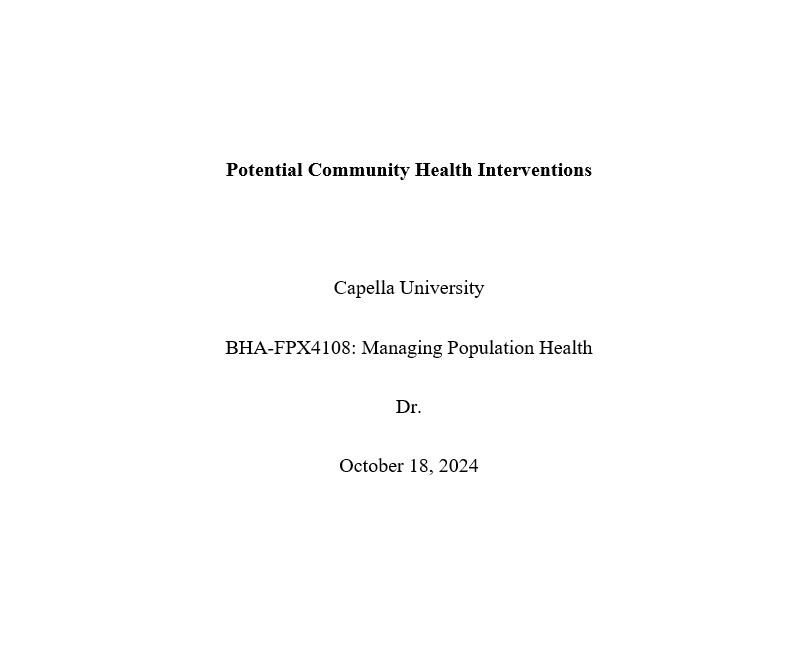Capella University
BHA-FPX4108: Managing Population Health
Dr.
October 18, 2024
Potential Community Health Interventions
Treatment and prevention measures make individuals and communities responsive to threats posed by different health conditions. Evidence-based practices call for the redesigning of approaches and skills to deliver patient-centered care. One health problem requiring significant improvements is obesity, which occurs when fats accumulate to the point of impairing one’s health. The complex condition gets worse over time and has negative effects including death. The issue exposes individuals to hypertension, mortality, stroke, diabetes, and other adverse conditions that undermine social and economic wellness.
Effects of Social Determinants on Individuals
The health improvement need addressed is obesity, which affects 18% of households in Owensboro. The prevalence reflects the situation in Kentucky, which is among the leading states for obesity in the United States. Data on adult and childhood obesity reinforces the need for proactive policy interventions to prevent and reduce obesity. The condition is the outcome of unhealthy eating habits, inadequate physical exercise, alcohol abuse, and other risks that undermine the ability to manage weight and prevent symptoms (Chumpunuch & Jaraeprapal, 2022). Obesity is a complex disease caused by an excessive amount of body fat. The disease causes circulatory complications, lung and breathing issues, metabolic diseases, and cancer. The community needs timely interventions such as training community-based health services providers to understand social determinants of health such as inadequate awareness, busy schedules, and several fast food restaurants. The program strengthens individual and collective commitment towards making healthy decisions and choices that help reduce obesity prevalence.
Obesity affects 18% of households in Owensboro. Notably, the community is in Kentucky, which is among the leading states for obesity in the United States. The leading cause is a culture of inactivity and emotional eating among children and adults. Ineffective programs for physical education and overeating as a coping mechanism increase the risk of high prevalence of obesity in the region. Further, Owensboro has a high density of fast food restaurants open at all hours, which expose residents to unhealthy eating habits (Chumpunuch & Jaraeprapal, 2022).The adult residents have a busy work schedule, which limit them from accessing behavioral, mental health, and dietary counseling.
The elderly population is vulnerable to unhealthy food choices made by family members. The difficulties in moving from one place to another limit the group from choosing healthy foods and avoiding those that induce obesity. Further, beliefs and socially adopted body image attitudes and perceptions make individuals vulnerable to obesity (Chumpunuch & Jaraeprapal, 2022). Ideally, others associate being overweight with wealth and financial stability. The perceptions trigger consumption of large amounts of food. The various social determinants of health trigger unhealthy food choices, considering inadequate awareness, busy schedules, and several fast food restaurants available within the community.
Additionally, the elderly are among the most affected populations since they have a constrained ability to choose their foods. Declining physical capabilities means that the elderly have to eat food brought by family members. Such inequalities increase obesity prevalence among older residents, hence the need for reforms that would enhance responsiveness to the health needs of the group. The various social determinants of health reinforce the need for collective aspirations toward developing interventions tailored to meet the needs of the most vulnerable groups such as aged residents. Treating obesity requires a comprehensive approach characterized by an individual and collective commitment to increasing physical activity and making healthy lifestyle choices.
Evidence-Based Treatment Model
Pharmacotherapy is an evidence-based treatment model to treat obesity. The method entails improved access to dietary supplements in health food stores, pharmacies, and grocery stores. Patients can also access supplements from online sources to enable them to achieve the recommended weight loss (Chaudhry, 2020). The advantages of the intervention include easy access, affordability, the absence of a prescription, and a limited need for behavioral modifications. Similarly, individuals with experiences of unsuccessful attempts at weight loss can utilize pharmacotherapy to achieve their desired target (Chaudhry, 2020). The low-income populations and less educated residents may also choose pharmacotherapy to manage weight. However, users may be vulnerable to ineffective weight loss supplements due to inadequate scientific evidence. A comprehensive treatment model could accommodate tailored programs that help more people to lose weight and learn to make healthier decisions. Proactive obesity promotion and education are necessary to make people aware of drugs approved by the Food and Drug Administration. The process makes users familiar with options such as phentermine and bupropion recommended for reducing risks caused by being overweight.
Evidence-Based Wellness Model
Evidence-based wellness model promotes sustainable education and promotion on serious diseases and health conditions that increase the healthcare burden across the community. The goal is to encourage individuals to focus on attitudes, behaviors, and actions that promote healthier lives (Soliman et al., 2018). Specifically, people learn to take charge of their health and well-being by eating smaller portions of food, embracing regular exercise, and utilizing weight-loss tutorials and counseling on healthy food.
The Health Belief model guides residents to appreciate prevention measures adopted across the community. In this case, healthcare professionals, community leaders, CHWs, and relevant affiliates explain recommended eating habits, physical activities, alcohol use moderation, and other practices that reduce the risk of obesity. Rural Health Information Hub (2022) encourages healthcare providers to emphasize the adverse consequences of being overweight and the need for personal responsibility and accountability toward maintaining the desired weight. An advantage of the Health Belief model is that it encourages self-efficacy in nutritional health and exercise (Soliman et al., 2018). The emphasis on behavioral interventions encourages vulnerable populations to adopt positive intentions characterized by awareness about adverse health outcomes associated with failure to manage weight.
The prevention model also creates opportunities for collaborations between schools, Owensboro Health Healthpark, and Owensboro Health Surgical Weight Loss Center. The collaborative framework promotes positive behaviors characterized by active participation in walks and runs, knowledge of healthy food and beverage choices, and physical activity necessary to improve quality of life. However, the emphasis on individual actions and behavior limits the theory from addressing issues such as the neighborhood food environment that limit residents from making healthier food choices. Additionally, the theory does not address the need for policy interventions that would enable fast-food outlets and restaurants to adjust their men and include healthier choices.
Conclusion
Prevention is the most effective means of reducing obesity prevalence. The approach involves behavioral interventions that make individuals aware of risks such as unhealthy eating habits and increased screen time associated with obesity. The process also encourages individual, family-based, and community approaches for encouraging healthy eating, adequate physical activity, and behavioral modifications. However, individuals could also utilize pharmacotherapies approved by the Food and Drug Administration to complement wellness initiatives. The decision safeguards obese individuals against severe complications and mortality threats associated with uncontrolled symptoms.
References
CDC. (2022). Community efforts. U.S. Department of Health & Human Services. https://www.cdc.gov/obesity/strategies/community.html
Chumpunuch, P., & Jaraeprapal, U. (2022). The social determinants of health influencing obesity for the aged in the Pakpoon community context: A qualitative study. International Journal of Nursing Sciences, 22, 211-221. https://www.ncbi.nlm.nih.gov/pmc/articles/PMC9052257/
Jane, M., Hagger, M., Foster, J., Ho, S., & Pal, S. (2018). Social media for health promotion and weight management: A critical debate. BMC Public Health, 18(932), 1-7. https://bmcpublichealth.biomedcentral.com/articles/10.1186/s12889-018-5837-3
Pearce, C., Rychetnik, L., Wutzke, S., & Wilson, A. (2019). Obesity prevention and the role of hospital and community-based health services: A scoping review. BMC Health Services Research, 19(453), 1-14. https://bmchealthservres.biomedcentral.com/articles/10.1186/s12913-019-4262-3
Richardson, M. (2019). Kentucky ranks eighth-worst state for obesity. The Owensboro Times. https://www.owensborotimes.com/life/health-wellness/2019/02/kentucky-ranks-eighth-worst-state-for-obesity/



